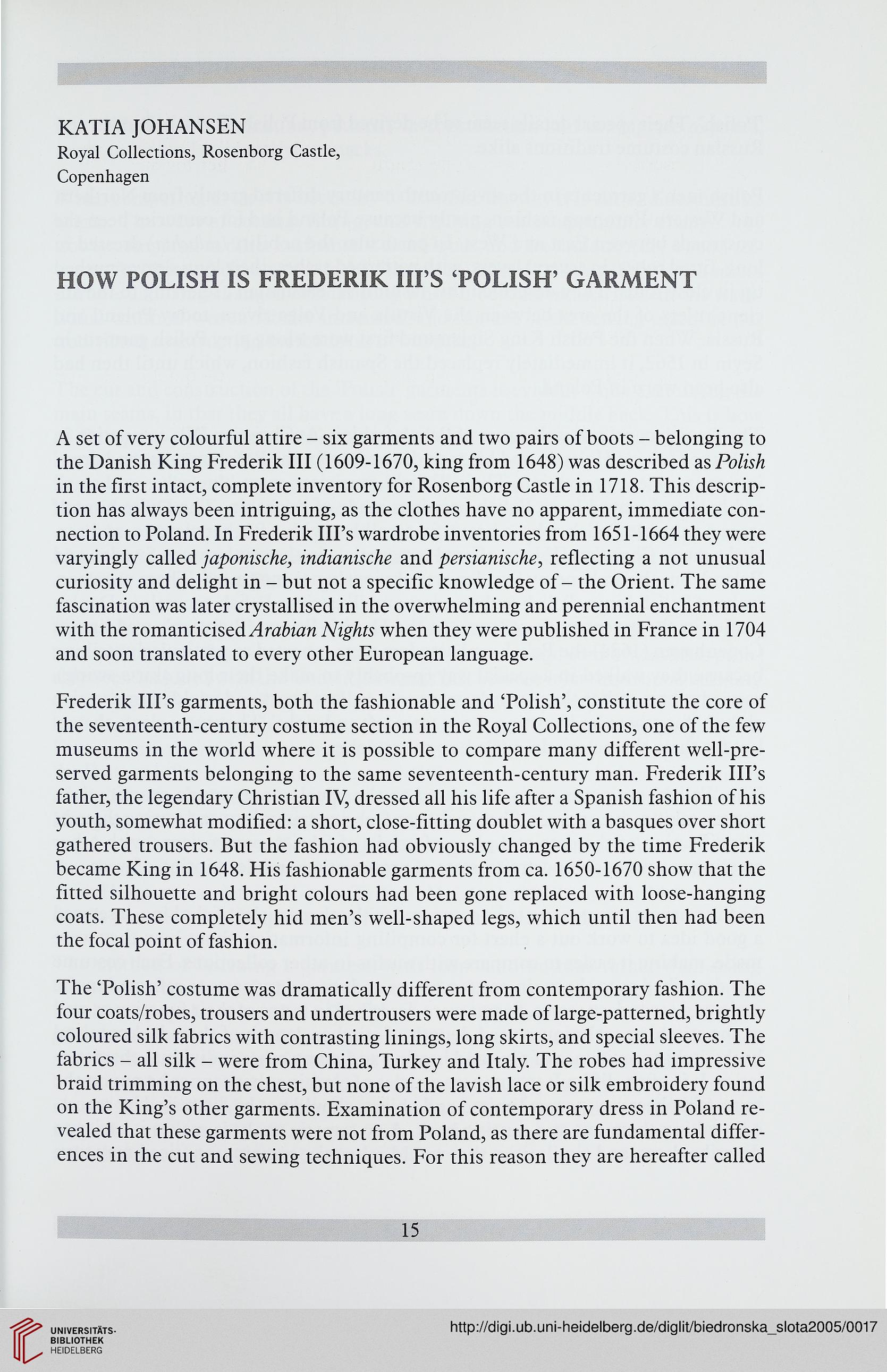KATIA JOHANSEN
Royal Collections, Rosenborg Castle,
Copenhagen
HOW POLISH IS FREDERIK IIFS 'POLISH' GARMENT
A set of very colourful attire - six garments and two pairs of boots - belonging to
the Danish King Frederik III (1609-1670, king from 1648) was described as Polish
in the first intact, complete inventory for Rosenborg Castle in 1718. This descrip-
tion has always been intriguing, as the clothes have no apparent, immediate con-
nection to Poland. In Frederik IIFs wardrobe inventories from 1651-1664 they were
varyingly called japonische, indianische and persianische, reflecting a not unusual
curiosity and delight in - but not a specific knowledge of - the Orient. The same
fascination was later crystallised in the overwhelming and perennial enchantment
with the romanticised/łrafoaw Nights when they were published in France in 1704
and soon translated to every other European language.
Frederik IIFs garments, both the fashionable and 'Polish', constitute the core of
the seventeenth-century costume section in the Royal Collections, one of the few
museums in the world where it is possible to compare many different well-pre-
served garments belonging to the same seventeenth-century man. Frederik IIFs
father, the legendary Christian IV, dressed all his life after a Spanish fashion of his
youth, somewhat modified: a short, close-fitting doublet with a basąues over short
gathered trousers. But the fashion had obviously changed by the time Frederik
became King in 1648. His fashionable garments from ca. 1650-1670 show that the
fitted silhouette and bright colours had been gone replaced with loose-hanging
coats. These completely hid men's well-shaped legs, which until then had been
the focal point of fashion.
The 'Polish' costume was dramatically different from contemporary fashion. The
four coats/robes, trousers and undertrousers were made of large-patterned, brightly
coloured silk fabrics with contrasting linings, long skirts, and special sleeves. The
fabrics - all silk - were from China, Turkey and Italy. The robes had impressive
braid trimming on the chest, but none of the lavish lace or silk embroidery found
on the King's other garments. Examination of contemporary dress in Poland re-
vealed that these garments were not from Poland, as there are fundamental differ-
ences in the cut and sewing techniąues. For this reason they are hereafter called
Royal Collections, Rosenborg Castle,
Copenhagen
HOW POLISH IS FREDERIK IIFS 'POLISH' GARMENT
A set of very colourful attire - six garments and two pairs of boots - belonging to
the Danish King Frederik III (1609-1670, king from 1648) was described as Polish
in the first intact, complete inventory for Rosenborg Castle in 1718. This descrip-
tion has always been intriguing, as the clothes have no apparent, immediate con-
nection to Poland. In Frederik IIFs wardrobe inventories from 1651-1664 they were
varyingly called japonische, indianische and persianische, reflecting a not unusual
curiosity and delight in - but not a specific knowledge of - the Orient. The same
fascination was later crystallised in the overwhelming and perennial enchantment
with the romanticised/łrafoaw Nights when they were published in France in 1704
and soon translated to every other European language.
Frederik IIFs garments, both the fashionable and 'Polish', constitute the core of
the seventeenth-century costume section in the Royal Collections, one of the few
museums in the world where it is possible to compare many different well-pre-
served garments belonging to the same seventeenth-century man. Frederik IIFs
father, the legendary Christian IV, dressed all his life after a Spanish fashion of his
youth, somewhat modified: a short, close-fitting doublet with a basąues over short
gathered trousers. But the fashion had obviously changed by the time Frederik
became King in 1648. His fashionable garments from ca. 1650-1670 show that the
fitted silhouette and bright colours had been gone replaced with loose-hanging
coats. These completely hid men's well-shaped legs, which until then had been
the focal point of fashion.
The 'Polish' costume was dramatically different from contemporary fashion. The
four coats/robes, trousers and undertrousers were made of large-patterned, brightly
coloured silk fabrics with contrasting linings, long skirts, and special sleeves. The
fabrics - all silk - were from China, Turkey and Italy. The robes had impressive
braid trimming on the chest, but none of the lavish lace or silk embroidery found
on the King's other garments. Examination of contemporary dress in Poland re-
vealed that these garments were not from Poland, as there are fundamental differ-
ences in the cut and sewing techniąues. For this reason they are hereafter called





